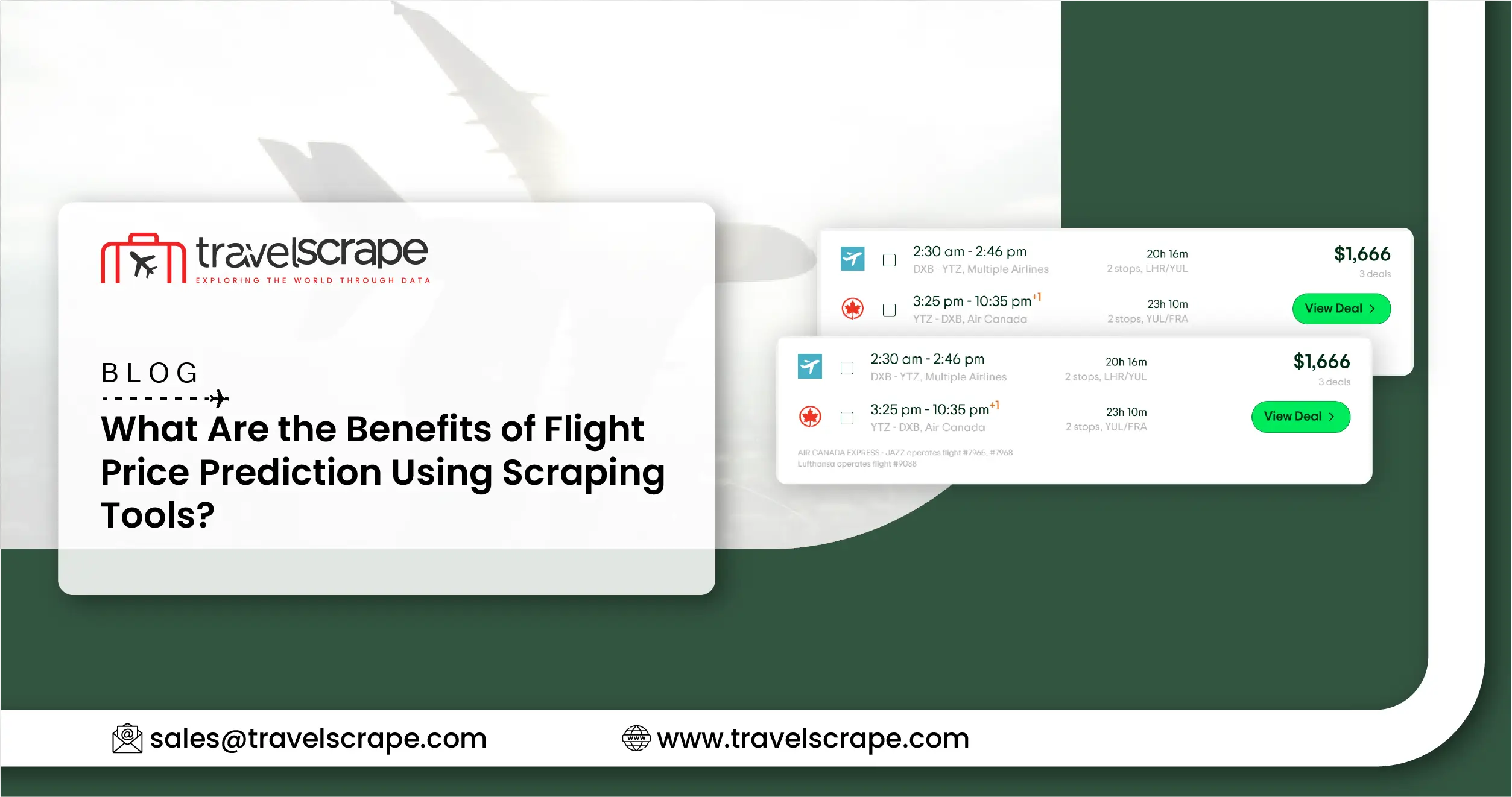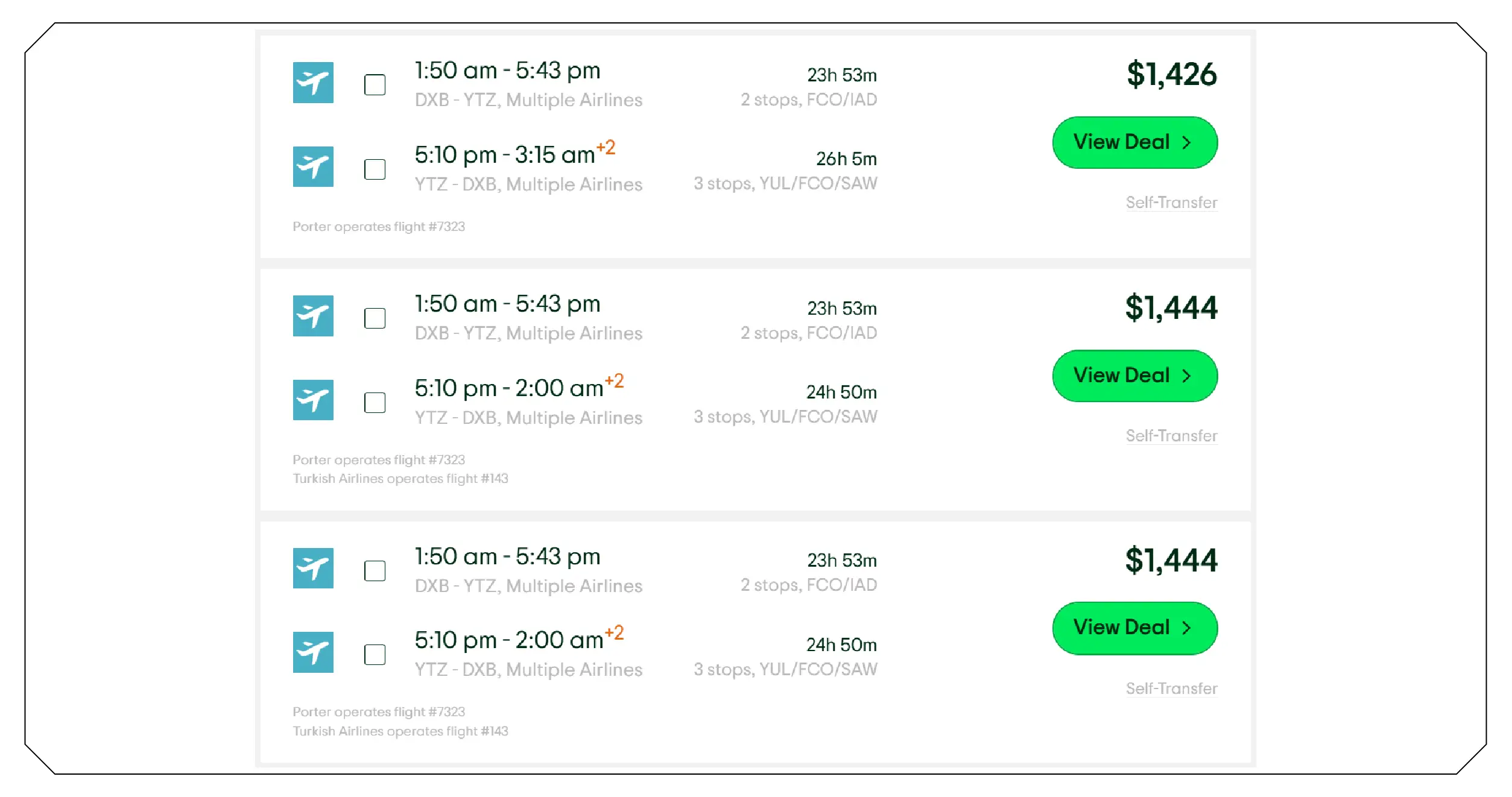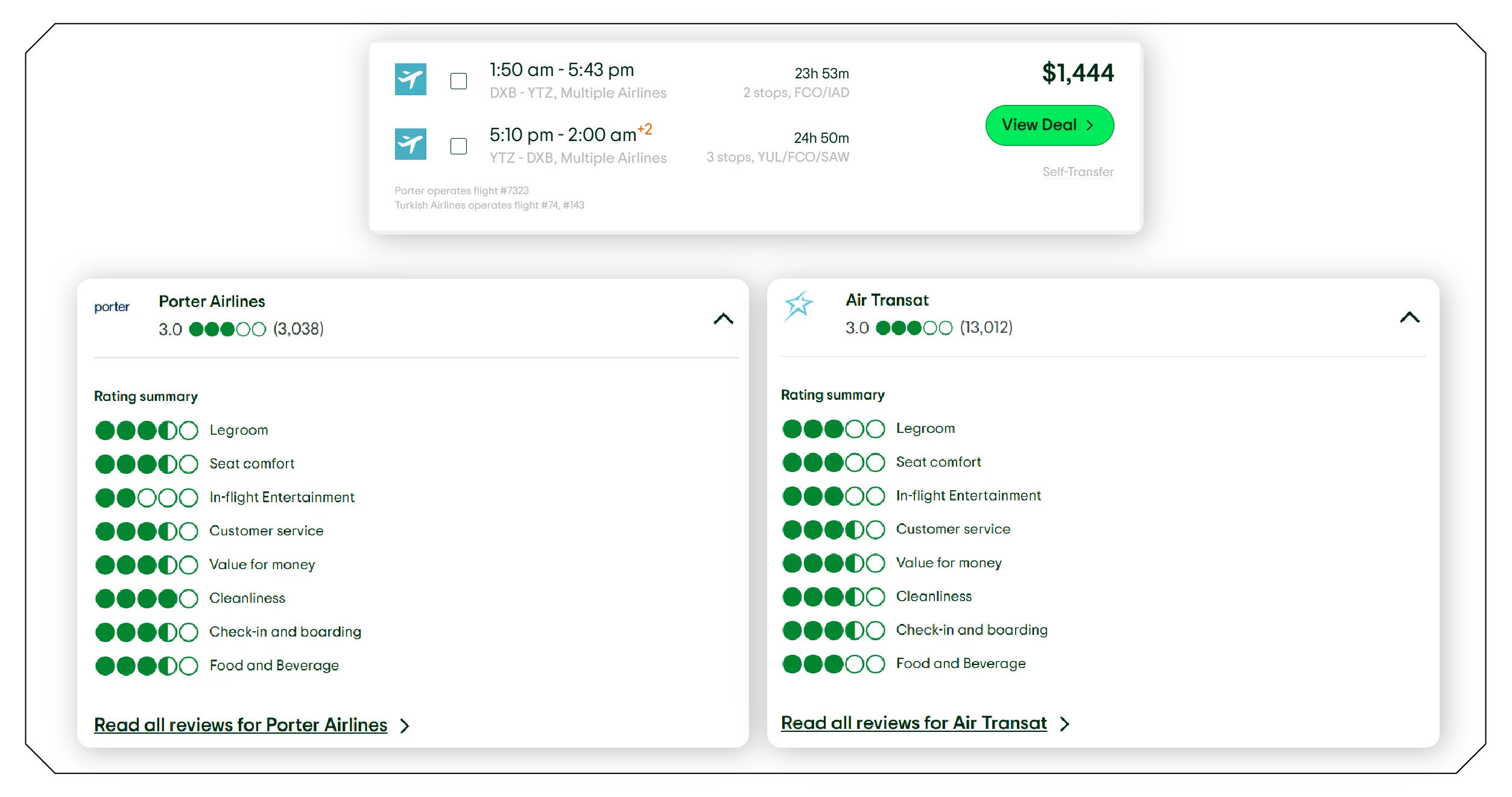What Are the Benefits of Flight Price Prediction Using Scraping Tools?

Introduction
Long weekends are prime time for short vacations, but they often come with the downside of unpredictable airfare hikes. As demand surges, flight prices can fluctuate dramatically, making it difficult for travelers to find affordable options. This is where Flight price prediction using scraping becomes a game changer. By extracting and analyzing airfare data across multiple platforms in real time, both individual travelers and travel agencies can make smarter booking decisions. The growing popularity of Flight price hike alerts reflects the urgency to stay ahead of sudden price shifts. Paired with advanced Flight Cost Analysis , this approach enables users to monitor patterns, compare fare trends, and anticipate price jumps well in advance of holidays. For travel agencies, it unlocks the ability to build more competitive packages. For consumers, it provides peace of mind and better budgeting. This data-driven edge is reshaping how people plan their long weekend getaways.
Understanding Price Surges During Long Weekends

Long weekends, often aligned with national or public holidays, have become peak travel periods. As a result, they are notorious for sudden airfare hikes due to increased demand. Airlines use dynamic pricing algorithms that respond in real time to search volume, booking trends, and seat availability. Historically, data has shown that flight prices can surge by as much as 60% just 3 to 7 days before popular long weekends, catching many travelers off guard.
This is where the importance of analyzing long weekend travel pricing becomes clear. By leveraging automated bots and crawlers, it's possible to continuously collect airfare data from multiple sources such as airline websites, travel portals, and aggregator platforms. This data is then used to detect patterns, monitor fluctuations, and identify peak pricing windows. These tools can reveal which routes are most susceptible to price changes, how far in advance prices start to rise, and when temporary drops occur.
For travel agencies and individual travelers alike, this real-time insight into price behavior is incredibly valuable. It enables strategic booking decisions, avoids last-minute surprises, and allows for better budgeting. In an environment where price changes can happen hourly, consistent monitoring offers a much-needed edge for smart travel planning.
How Does Data Scraping Help?
The collection of airfare pricing across multiple sources is tedious and nearly impossible to perform manually on a daily basis. But by integrating web scraping, a business can automate this task.
Using scraping bots, it becomes possible to collect departure and arrival city combinations, date-specific price ranges, flight durations, number of stops, airline names, and even baggage rules. This generates real-time flight pricing insights that can be further analyzed using predictive models.
- Tracks Real-Time Price Fluctuations: Continuously monitors airline websites and travel portals to capture dynamic changes in airfare before and during long weekends.
- Identifies Historical Trends: Analyzes past flight pricing patterns to forecast expected price surges ahead of holidays or weekends.
- Detects Price Drop Windows: Flags short-lived fare reductions so travelers or agencies can act quickly to secure lower prices.
- Compares Multiple Sources: Aggregates data from various platforms to offer a unified view of competitive pricing across airlines and routes.
- Enables Smart Alerts & Automation: Powers predictive alerts and automated dashboards to notify users when prices rise or fall significantly.
Benefits for Travel Agencies and Platforms

With the growing popularity of Travel Industry Web Scraping Services , agencies now understand the importance of real-time data for:
- Recommending low-cost alternatives
- Alerting customers in advance about possible hikes
- Offering personalized travel deals
- Building loyalty apps that notify users in real time
Data-driven strategies increase trust among travelers and improve conversions.
Models Used in Predictive Analysis
Once the scraping infrastructure is in place, machine learning and AI are used to detect future trends. Some of the models include:
- Time Series Forecasting
- Price Optimization Algorithms
- Regression-Based Fare Predictions
- Demand vs Supply Data Merging
By leveraging airfare inflation tracking insights , these models allow platforms to set intelligent alerts, improve customer experience, and avoid last-minute surprises.
Tracking Live Changes Before Long Weekends
Web scrapers empower travel agencies to track real-time airfare changes , down to hourly or even 10-minute intervals. This rapid tracking is especially valuable during the lead-up to long weekends such as Labor Day, Thanksgiving, or Memorial Day, when flight prices tend to fluctuate drastically due to sudden demand surges.
By automating the data collection process across airline websites and third-party travel platforms, agencies gain a continuous stream of updated fare information. This includes both major airlines like United, Delta, and Southwest, as well as budget carriers such as Spirit and Frontier. Flight price data scraping ensures every fare change is logged and stored, creating a comprehensive dataset that enables agencies to analyze pricing behavior over time.
Such high-frequency data scraping supports pattern recognition, helping agencies anticipate potential price hikes or rare drop windows. The resulting insights not only allow agencies to recommend optimal booking windows to travelers but also power internal pricing strategies and travel package offerings. Track real-time airfare changes in competitive holiday travel markets to see that even slight timing mismatches can lead to higher costs or lost bookings.
Impact on Consumer Behavior
The rise of price prediction tools and airfare alerts has transformed how consumers approach travel planning. Travelers today are no longer rushing to book at the first sign of a deal. Instead, they've become more strategic, waiting for alerts or using data-driven aggregator platforms that show historical trends, fare predictions, and last-minute drop patterns. This shift in behavior is primarily fueled by access to scraped flight data, which keeps travelers informed and in control.
Rather than making impulsive decisions, many users now subscribe to fare alert services or use travel apps that analyze real-time and historical data. These platforms notify users when prices drop, increase, or are likely to change based on past behavior, enabling smarter booking decisions.
For travel agencies and booking platforms, this shift offers valuable insight into customer behavior. By studying how and when users engage with price alerts, platforms can better understand preferred booking windows. This data supports the creation of tailored recommendations, targeted travel deals, and curated weekend getaway packages, enhancing user engagement while aligning offers with consumer expectations.
Best Practices in Data Collection
- Respect robots.txt files
- Use rotating proxies
- Add delays between requests
- Avoid overloading servers
Adopting these practices ensures the longevity and compliance of scraping operations.
Role of Data Visualization
Scraped airfare data can be overwhelming without visual tools. Through charts, heatmaps, and calendars, long weekend patterns can be visualized.
Dashboards can show:
- Price hikes over time for a route
- Cheapest days to fly in a 60-day window
- Airline vs. price performance
Such tools enable web scraping for travel agents to drive strategic campaign planning.
Increased Accuracy Over Time
With months of historical pricing data stored and scraped regularly, travel agents predict airfare hikes using scraping with over 80% accuracy. This turns every data point into a competitive advantage.
Flight prices generally follow similar patterns, with slight deviations due to weather, political changes, or pandemics. By analyzing anomalies, platforms refine their logic year after year.
Use Cases Across the Industry
- Meta-search aggregators like Kayak or Skyscanner
- Personalized trip planning apps
- Corporate travel cost benchmarking
- Airline competitive pricing dashboards
Data has become the cornerstone for innovation in how we plan and purchase air travel.
Future of Fare Tracking During Peak Times
With the rise of generative AI and NLP, fare tracking systems are expected to become more conversational. Users might ask, "When should I book my next NYC to Miami trip?" and receive insights that are scraped, analyzed, and presented with visual timelines.
Combining scraping with user intent opens up possibilities like never before. Travel bots could integrate calendar events, school holidays, and weather forecasts into fare predictions.
How Travel Scrape Can Help You?
- Real-Time Monitoring — We offer robust systems to track real-time airfare changes, capturing data at hourly or even minute-level intervals from both airline websites and travel aggregators.
- Multi-Platform Coverage — Our scrapers collect data from a wide range of sources—major airlines, budget carriers, and OTAs—ensuring flight price data scraping is comprehensive and competitive.
- Historical Pricing Datasets — We build and maintain historical fare datasets, enabling deep analysis of trends, price fluctuations, and booking windows for predictive insights.
- Customized Alerts & Dashboards — We deliver structured data with customizable alerts or integrate with dashboards, helping you stay ahead of fare drops and surge patterns.
- Holiday & Peak Season Tracking — We specialize in high-frequency scraping during high-demand periods, such as long weekends and festivals, to support strategic pricing and customer engagement.
Conclusion
To assist users in maximizing savings, modern platforms and agents are increasingly investing in tools to track airfare changes. By deploying tools to track flight prices for long weekends, they are bridging the gap between unpredictability and informed travel planning.
Moreover, companies investing in travel data scraping for long weekend trends are not only saving costs but also improving brand reputation by offering proactive insights. Choosing the best scraper for airline ticket price tracking becomes critical in ensuring accuracy, consistency, and speed of data delivery.
With the right strategy, web scraping becomes the secret weapon for smarter, faster, and more economical travel experiences during every long weekend.
Ready to elevate your travel business with cutting-edge data insights? Get in touch with Travel Scrape today to explore how our end-to-end data solutions can uncover new revenue streams, enhance your offerings, and strengthen your competitive edge in the travel market.

